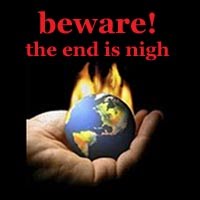
Jim Hansen, head of the NASA climate science team. Why's his research not appearing in the mainstream media?
by Bill Henderson
15 April 2008
Countercurrents.org
Imagine you have a choice between two scenarios on the future impact of climate change:
Scenario A: Climate change is real and human-caused, a gradual increase in global temperature that we have a long time to do something about (2050 targets) before drought, sea level rise, etc. get too severe; climate change can be effectively mitigated within continuing political and economic business as usual with carbon taxes and more efficient green technology.
Scenario B: Climate change is an emergency where we must make Draconian cuts to our use of fossil fuels immediately and globally in order to reduce greenhouse gases in the atmosphere this decade so that we don't continue over a tipping point where both polar ice caps melt completely, sea level rises by 75 meters, and conditions become fiercely inhospitable to humanity and most of the species with which we share this small blue planet. Political and economic business as usual is far too slow and path dependent for mitigation of this scale, so we must innovate a World War II-style government mobilization so that a systemic reconfiguration of the global economy is possible.
Thousands of mainstream media articles and commentaries on TV, in newspapers and magazines, inform about climate change Scenario A, but there has been minimal, almost nonexistent mainstream coverage of Scenario B even though its main proponents - James Hansen and his NASA climate science team - have released several papers explaining this nonlinear vision of climate change focusing upon the unpredicted rapid melting of the polar ice caps.
Very few people outside of climate scientists and climate activists even know about Hansen's polar ice melt hypothesis and what it means to each of our distant and more immediate futures. There is probably a scientific debate raging in labs and symposia about this new and compelling vision of climate change, but since publics globally remain, surrealistically, almost completely uninformed, how would we know?.
For example, Andrew Revkin, the NY Times expert and dean of American climate science reportage, mentioned the Hansen et el latest paper Target Atmospheric CO2: Where Should Humanity Aim? only through his Dotearth blog with no coverage in the Times newspaper at all. At Dotearth he quotes from the paper's summery:
Humanity today, collectively, must face the uncomfortable fact that industrial civilization itself has become the principal driver of global climate. If we stay our present course, using fossil fuels to feed a growing appetite for energy-intensive life styles, we will soon leave the climate of the Holocene, the world of human history. The eventual response to doubling pre-industrial atmospheric CO2 likely would be a nearly ice-free planet.
Humanity's task of moderating human-caused global climate change is urgent. Ocean and ice sheet inertias provide a buffer delaying full response by centuries, but there is a danger that human-made forcings could drive the climate system beyond tipping points such that change proceeds out of our control. The time available to reduce the human-made forcing is uncertain, because models of the global system and critical components such as ice sheets are inadequate. However, climate response time is surely less than the atmospheric lifetime of the human-caused perturbation of CO2. Thus remaining fossil fuel reserves should not be exploited without a plan for retrieval and disposal of resulting atmospheric CO2. Paleoclimate evidence and ongoing global changes imply that today's CO2, about 385 ppm, is already too high to maintain the climate to which humanity, wildlife, and the rest of the biosphere are adapted.
But the vast majority of NY Times newspaper readers, Americans in general, and people globally have never even heard of this emerging vision of climate change let alone been informed and educated by critical commentary from those with relevant expertize.
Hansen's emerging climate change vision and climate change A are almost mutually exclusive. Today's nascent climate change mitigation measures, including carbon taxes and cap and trade, remain completely within the gradual, linear, conventional wisdom. This level of mitigation does not address the big ice sheet melt as a crucial tipping point. No governments anywhere - not even those governments that have led in acknowledging climate change as a real and serious problem - are even remotely considering mitigation measures of an immediacy and scale needed to try to return atmospheric CO2 emission levels below 350 ppm.
Climate change B is an impossibility within our present political and economic systems.Which is probably why you haven't heard about Hansen's new climate change information and possible Draconian mitigation strategies in the mainstream media.
If you want to know more about climate change B, you can go to Hansen's web site and read the papers and other presentations detailing this vision. You can search through blogs for a critical appraisal of the science and what it means for present mitigation strategies.
And there is an excellent presentation of the Arctic melt science, including invaluable communications and policy formation chapters based upon this science by two Australians, Sutton and Spratt, in a report, Climate Code Red, published in February. Their characterization of this climate change as an emergency requiring immediate action beyond the capacity of political and economic business as usual arguably makes Climate Code Red the most important document published so far this year - a possible Nobel Prize contender even. But you almost certainly have never even heard about its existence before now, because Climate Code Red received no mainstream coverage at all, not a single mention - let alone pertinent critical coverage.
An equivalent report, even one released by an NGO (Climate Code Red was published by the NGO Friends of the Earth) usually receives media coverage averaging over one hundred Google News citations. A report on commercial adoption of genetically modified crops, released the same week in February, for example, had more than 160 citations with coverage by all mainstream broadcasters and publishers. Sutton and Spratt's emergency response message was obviously too heretical, hence this outrageous news anomaly.
So your choice: a climate change that doesn't threaten your lifestyle and future aside from a couple of pennies increase at the pump (the new climate change denial?), or you can choose to search out more about this year's very inconvenient truth about climate change, a sobering vision of climate change equivalent maybe to receiving the news from your doctor that you have a potentially terminal disease with only a slim chance of survival (our kids' future, humanity's future) - unless you make seemingly impossible, drastic lifestyle changes immediately.







No comments:
Post a Comment